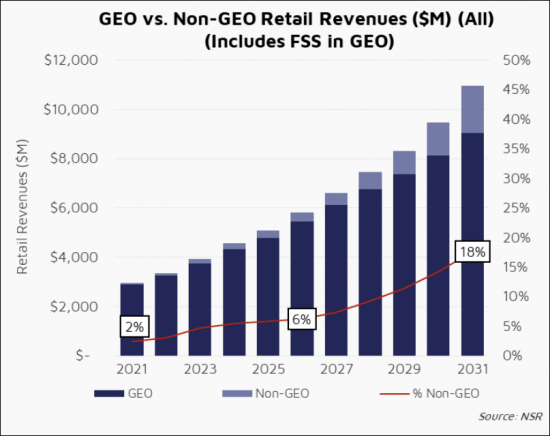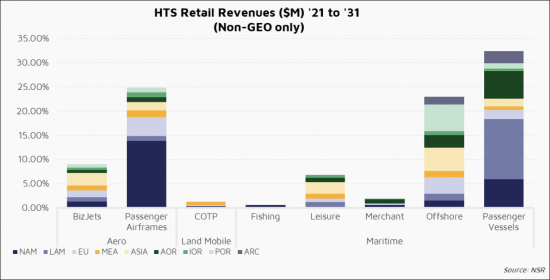|
市場調査レポート
商品コード
1108739
LeoおよびMeoブロードバンド衛星モビリティ市場Leo & Meo Broadband Satellite Mobility Markets |
|||||||
| LeoおよびMeoブロードバンド衛星モビリティ市場 |
|
出版日: 2022年08月02日
発行: Northern Sky Research, LLC
ページ情報: 英文
納期: 即日から翌営業日
|
- 全表示
- 概要
- 目次
LeoおよびMeoブロードバンド衛星モビリティは、海洋やその他の従来接続されていなかった地域に大きな容量をもたらす可能性があり、ワイドビームFSSアーキテクチャから、スポットビームGEO-HTSインフラへの移行が進んでいる従来のGEO中心の市場をディスラプトするものとなっています。

当レポートでは、LeoおよびMeoブロードバンド衛星モビリティ市場について調査し、商業航空、陸上移動、海上輸送のエンドユーザー別の非GEO-HTS接続の機会評価、エンドユーザーの採用や既存のGEOベースのソリューションからの移行を促進する主な要因、同市場に参入しているLEOおよびMEO HTSプロバイダーなどの情報を提供しています。


目次
エグゼクティブサマリー
第1章 モビリティ市場における非GEOの状況
- LEOのレビュー
- 主な非GEO HTS企業
- 供給映像
第2章 市場の課題
- 主なエンドユーザーの質問
- サービスプロバイダーパラダイム
- 衛星運用者のジレンマ
第3章 モビリティ市場の予測
- オービットおよびサブセグメント別:小売収益
- 地域別:非GEO HTS小売収益
- 稼働中のユニット
- 軌道およびセグメント別:HTS容量の需要
- 結論
Report Summary:
NSR's “LEO & MEO Broadband Satellite Mobility Markets report (LMBSMM) ” assesses the 'big question' faced by the satellite communications industry today- what is the impact of current or emerging Non-GEO HTS satellite constellations? NSR's “LMBSMM” provides recommendations for service providers, and satellite operators to understand key messages resonating most with end-users to help improve their market positioning.
NSR's “LEO & MEO Broadband Satellite Mobility Markets report (LMBSMM) ” offers a detailed analysis of both LEO and MEO orbits using Ku and Ka-bands. These systems by their global nature have the potential of bringing significant capacity to oceans and other traditionally under-connected regions - disrupting a traditionally GEO-centric market that is still undergoing a transition from wide-beam FSS architectures to spot-beam GEO-HTS infrastructure.
Overall, NSR's “LMBSMM” provides business-critical insights and analytics for the how, where, and why of these LEO & MEO options and their influence on the 10-year outlook for Ku- and Ka-band Broadband Mobility Markets.

This Report does not answer the question of "LEO viability", nor does it provide specific market shares or projections around each of these leading Non-GEO HTS constellations. While these are other key considerations around the Non-GEO HTS market, those questions are answered elsewhere in NSR's library of research.
Who Should Purchase this Report:
- Investors looking to understand and spotlight impacts or opportunities for LEO & MEO services in commercial mobility end-user segments
- Investors and financial institutions
- End-users looking to benchmark their current connectivity roadmaps
- Strategy, planning and business intelligence teams with satellite operators
- Product or vertical managers at Satellite Service Providers
- Satellite manufacturers and integrators
- Data analytics companies
- Distributors, Service Providers, Retailers and Resellers of Satellite Services
- Network Operators
Key Features:
Covered in this Report:
- Assesses the opportunity for Non-GEO-HTS connectivity from commercial Aeronautical, Land-Mobile, and Maritime End-users
- Examines the key factors driving end-user adoption and/or migration from exiting GEO-based solutions
- Highlights the key LEO & MEO HTS providers approaching this market
- Analysis of the LEO & MEO HTS provider path to market
- Evaluates the where, when, and how of GEO keeping competitive in the longer term
- Compiled viewpoint of the commercial mobility opportunity from an In-Service unit, Capacity Demand and Revenue component, split by each mobility end-user segment (Aero, Land, Maritime)


Table of Contents
Executive Summary
1. State of Non-GEO in Mobility Markets
- 1.1. LEO Review
- 1.2. Key Non-GEO HTS Players
- 1.3. Supply Picture
2. Market Challenges
- 2.1. Key End-user Questions
- 2.2. Service Provider Paradigm
- 2.3. Satellite Operator Dilemma
3. Mobility Market Forecasts
- 3.1. Retail Revenues by Orbit and Sub-Segment
- 3.2. Non-GEO HTS Retail Revenues by Region
- 3.3. In-Service Units
- 3.4. HTS Capacity Demand by Orbit and Segment
- 3.5. Bottom Line
